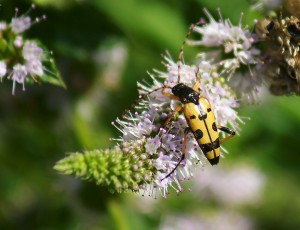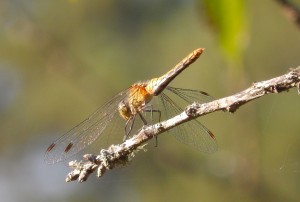


Today the morning sun blazed from a clear blue sky and the air around the tall handsome Fennel outside the kitchen swarmed with insects of all shapes and sizes, hastening to benefit from the plant’s abundant nectar. Among the visitors were the large black-and-yellow potter wasp, a small sand-wasp (Ammophila pubescens) – still a largish wasp, and a handsome species with its red and black abdomen – and an all-black spider-hunting wasp, like an Anoplius (and maybe of that genus) but without the red bands on the abdomen. Also enjoying the feast were many tiny solitary bees and a good number of flies of different species, including one with a long bristly red cylindrical abdomen, as well as what look very much like ordinary social wasps. A single red-and-black striped Trichodes alvearius beetle joined in.


The garden Mint, now coming into full bloom, had an almost entirely different set of insects on and around it, including large flies (preyed on by Crab Spiders), a Strangalia maculata longhorn beetle, and a Sooty Copper. Half a dozen Gatekeeper butterflies chased about; a Wall Lizard scurried down the wall on the lookout for insect prey. A Large Skipper perched for nectar.

In the evening, two dragonflies hunted over the lawn. A Small Pincertail hawked up and down, its abdomen showing a roughly striped yellow and black appearance as it flashed past, wheeling up and turning aerobatically like a military helicopter over the box hedge. A Common Darter chose a perch at the end of any of three bare twigs on the Cherry, darting up like a Flycatcher, hovering, and landing again, often on the same perch. It was hard to see its markings against the light, even with binoculars, but by stalking it with the camera and adjusting the brightness and contrast it was possible to see its orange coloration and rather plain markings, as well as clear wings, excluding Yellow-Winged and Ruddy Darters, both of which I’ve seen here.


This rather beautiful small Mantis with a ‘millefiore bead’ pattern on its eye was resting on the kitchen shutters. I’ve never seen the species before: it is much shorter than the common green Praying Mantis of Europe that we get here (mainly on chalk, but also in sandy clay meadows), and it is probably well camouflaged in brownish grass or vegetation. The wings are surprisingly clear, so there is no startling ‘deimatic’ flash of bright colour available from the forewings. There seems no doubt, though, about the ‘praying’ front legs (I almost said ‘arms’).
Other insect visitors include Southern White Admiral and Scarce Swallowtail (actually commoner here than the ‘Common’ Swallowtail, a fast flier which we sometimes see).
